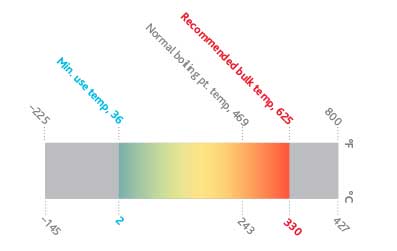How to Select the very best Heat Transfer Fluid for Industrial Applications
How Warmth Transfer Fluid Adds To Sustainable and Affordable Workflow
In the modern industrial landscape, the function of warmth transfer liquids (HTFs) in advertising lasting and cost-effective procedures can not be overstated. These fluids are critical in enhancing thermal monitoring systems, thus significantly enhancing energy efficiency and lowering functional prices. heat transfer fluid. The ecological benefits of advanced HTFs, with their high thermal stability and low poisoning, are undeniable.
Recognizing Warmth Transfer Liquids
In the realm of thermal monitoring, warmth transfer fluids (HTFs) serve as crucial representatives for transferring thermal power from one place to another. These liquids play an essential role in numerous commercial applications, including chemical handling, power generation, and Heating and cooling systems.
The structure of heat transfer liquids can vary dramatically, including options such as mineral oils, artificial oils, glycols, and molten salts. Each type provides distinct advantages, such as boosted thermal stability, reduced thickness, and high boiling factors, which are picked based on specific operational needs. In addition, the choice of HTF influences not only the effectiveness of heat transfer yet likewise the long life and safety of the system in which it is used.
As industries continue to introduce, the development of advanced HTFs, characterized by their boosted thermal conductivity and reduced environmental effect, is critical for satisfying the needs of contemporary thermal monitoring obstacles.

Enhancing Energy Efficiency

Improving power performance has actually come to be a vital problem throughout numerous sectors, motivating a more detailed assessment of warmth transfer liquids' function in enhancing thermal administration systems. These fluids are integral to maintaining the desired temperature in processes, thereby minimizing power waste and improving general system effectiveness. By choosing a suitable heat transfer fluid, sectors can dramatically boost their energy performance, leading to reduced power usage.

Advanced solutions of warm transfer fluids have actually been established to endure extreme temperature levels while preserving stability and performance. These innovations expand the operational lifespan of the liquid, minimizing the frequency of substitutes and energy-intensive upkeep activities. In addition, the usage of synthetic or bio-based fluids offers fringe benefits in regards to decreased ecological effect, lining up with global sustainability objectives. Improving energy effectiveness with ideal warmth transfer liquid selection is not only a technological necessity however also an environmental vital.
Lowering Operational Costs
Operational expenses are a considerable factor to consider for sectors looking for to keep affordable benefit, and the option of warmth transfer fluid plays an important duty in cost monitoring. Choosing a proper warm transfer liquid can result in significant price financial savings by enhancing system effectiveness and decreasing power consumption. High-performance fluids reduce thermal destruction, which consequently minimizes the regularity of liquid replacement and downtime linked with maintenance, consequently lowering operational expenditures.
In addition, heat transfer fluids with superior thermal security and rust resistance expand the life-span of equipment. This minimizes the need for frequent repairs and replacements, Get the facts which can be costly and turbulent to procedures. By buying top notch liquids, markets can achieve long-term decreases in maintenance costs and improve the integrity of their systems.
Additionally, progressed warmth transfer liquids commonly display reduced viscosity at operating temperatures, which improves pump efficiency and decreases power usage in liquid flow. This optimization of power consumption straight equates into reduced functional costs. Many modern-day warm transfer fluids are engineered to run successfully over a wide temperature range, minimizing the need for several liquid kinds, thus improving inventory needs and reducing associated expenses. These aspects jointly add to even more lasting and affordable operations.
Environmental Influence Decrease
The press towards lowering ecological effect has actually gained energy in markets leveraging warm transfer liquids. Warmth transfer liquids (HTFs) play a vital role in this shift, supplying opportunities to enhance power effectiveness and lower emissions - heat transfer fluid.
Additionally, making use of innovative warmth transfer fluids adds to better system performance, lowering the total power usage. This reduction not just causes expense financial savings but also decreases carbon dioxide discharges, assisting in the battle against environment modification. Liquids that are biodegradable and recyclable even more improve sustainability efforts, as they decrease waste and advertise round economy techniques.
Furthermore, integrating HTFs right into closed-loop systems avoids fluid loss and contamination of the surrounding atmosphere. This method makes sure that liquids are reused, lowering the need useful site for brand-new resources and restricting waste generation. By embracing these ecologically aware approaches, industries can considerably lessen their eco-friendly influence while preserving high operational efficiency, straightening with worldwide sustainability goals and governing requirements.
Choosing the Right HTF
Picking the ideal heat transfer liquid (HTF) is a crucial action in advancing ecological sustainability within industrial processes. The choice of HTF straight influences system efficiency, power usage, and ecological influence. An optimal HTF must have a high thermal capability, low viscosity, and high thermal conductivity to make certain efficient warmth transfer. In addition, its security over a wide temperature level additional resources range is important to avoid degradation, which can cause increased exhausts and waste.
When picking an HTF, it is vital to consider its compatibility with system materials to stay clear of deterioration and chain reaction. This ensures durability and decreases maintenance prices. Moreover, the liquid needs to be non-toxic and eco-friendly, lessening its environmental footprint and ensuring compliance with ecological guidelines. The lifecycle cost of the HTF, incorporating procurement, operation, and disposal, should additionally be assessed to make sure economic usefulness.
Verdict
